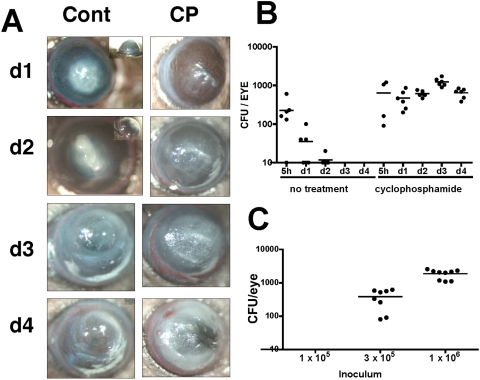Figure 2.
Biofilm-associated Fusarium keratitis in untreated and cyclophosphamide-treated C57BL/6 mice. C57BL/6 mice were either untreated or immunosuppressed by intraperitoneal injection of cyclophosphamide (CP). The corneas were abraded, and silicone hydrogel contact lenses (lotrafilcon) with Fusarium biofilm were placed on the ocular surface for 2 hours and examined at indicated time points thereafter. (A) Representative corneas of immunocompetent C57BL/6 mice, which were given a 1-mm-diameter abrasion, exhibited severe opacification on day 1 and day 2, and resolved after day 4. In contrast, corneas of CP-treated mice, which received three parallel scratches, showed increasing opacity, over time and perforation after day 4 (not shown). (B) Eyes of immunocompetent and immunosuppressed (CP) mice were enucleated on days 1 to 4, and CFUs were counted. Data points represent individual corneas and mice, and the data are combined from two repeat experiments. P < 0.05 between untreated and CP-treated mice at each time point except 5 hours. (C) The limit of detection of Fusarium colonies in CP-treated mice. Biofilm was generated with a starting inoculum as shown (1 × 105, 3 × 105, and 1 × 106 conidia per mL PBS). Corneas were then abraded and incubated with contact lenses with adherent biofilm, mice were euthanatized and CFUs were counted on day 1.

